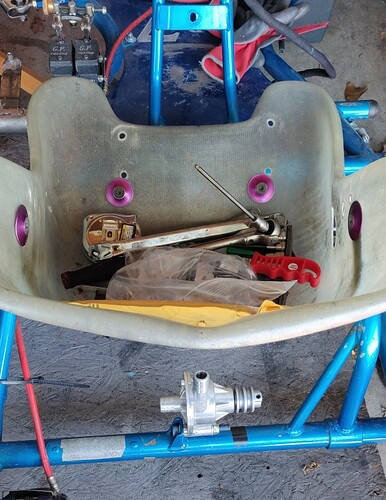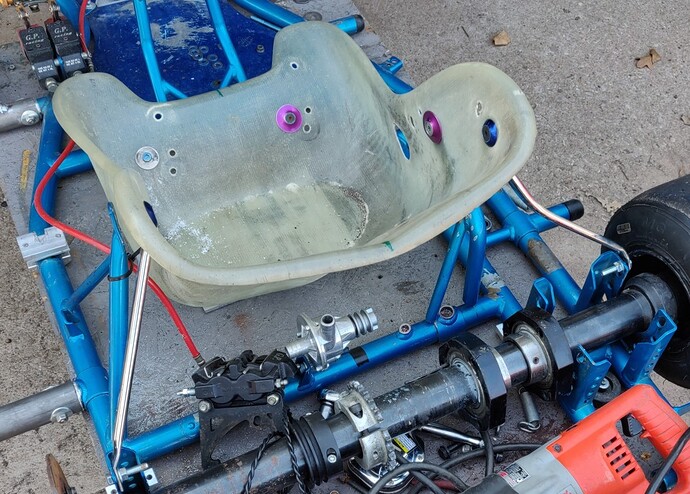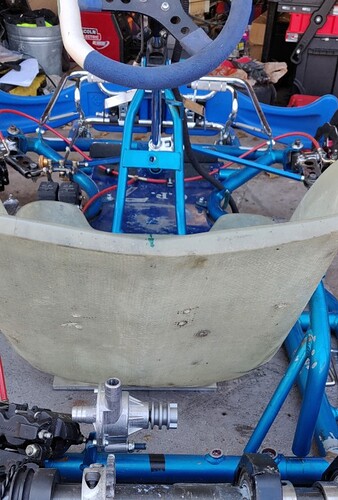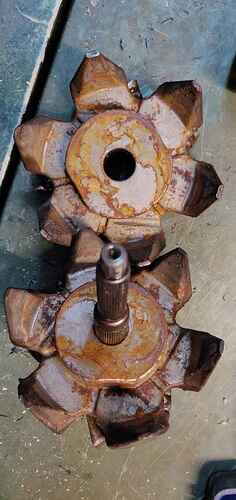Final step? What’s your completion estimate time wise? Looking great.
Seat moved, much better. Before off-center and angled to the right:
After:
Nicely aligned now. Green marks on the back and front of the seat align with the steering shaft:
Next, get the tube bent and flattened to make the new supports, and get them welded on. Then get the frame stripped, painted, and re-assembled.
May, assuming the motor arrives by then. Hopefully before the Indy 500.
Good luck!  20 chars
20 chars
Slow progress my with spring cleanup outside and other house repairs… Oh the joy of home ownership.
I have updated the spreadsheet to add some of the newer Motenergy motors and LifePO4 cells, as I’ve been looking into what it would take to build and sell kidkarts commercially. Best opened in excel with macros activated. EkartGo.xlsm
Motor-wise myself, I found out yesterday that due to supply-chain issues, I probably will not have the test motor until June/July. Ouch…
Battery-wise, I didn’t like the overall weight of the aluminum mount and case, so it’s been redesigned using FR4 fiberglass plates (electrically and fire safe) layered with S2 fiberglass for ultimate impact resistance (better than kevlar).
I imagine supply chain issues have caused delays?
Yes, they are waiting on coils and magnets. Oh well, gives me more time to work on kidkart designs for my grandchildren.
Electric Kid karts? Tell us more?
The goal is to build a kid kart that is initially inexpensive, has the battery capacity to last all day on one charge, and a programmable controller to limit the motor to top-end Honda GHX50-ish power (what they run locally). It will be air cooled and IP65+ rated so it can run in the rain.
I’m currently looking for a “local” roller to start. I plan to employ my grandkids for the R&D testing, with my younger granddaughter being the top candidate. I have a good handle on the motor, controller, BMS, and battery size.
Once the bugs are worked out, I will build at least two more so they can race as a class.
Sounds awesome. I was reading today that we are being told many things are required for us to not collectively bake ourselves to oblivion with greenhouse gases. One of the mandates was basically replacing the ICE. This line of experimentation of yours is likely timely.
TLDR: Net zero means huge declines in the use of coal, oil and gas. This requires steps such as halting sales of new internal combustion engine passenger cars by 2035, and phasing out all unabated coal and oil power plants by 2040
The kid kart angle is clever.
The energy requirements (thinking of infrastructure here) are so much lower with kid karts. It makes perfect sense to start there.
I’m sure you’ve seen the karts driven by electric drills.
One thing that’s become very apparent to me lately is how little “speed” matters to racers these days.
All of the projects I’ve seen are big on offering two stroke TaG type performance, but if you look at the most popular classes in the US that are burning dinosaur juice… That might not be the way to go.
Motor and controller wise I think this would be adequate for a kid kart and possibly cadet. This is an ME1717 with Kelly controller. Pair that with a BMS to make running and charging safe and a 2kWh battery and it should move.
I do have a cadet chassis, but would rather put this on a kid kart - still looking if someone has one (no motor required).
Update on the kid kart…
Still no chassis - it is proving more difficult than I imagined to find one.
Motor
I pulled a guinea pig 135 Amp alternator from a Ford Freestar for the permanent magnet test conversion. I removed the brushes, diode board, and rotor coils. I will need to extend the lead wires, machine the rotor, add a magnet, add hall sensors, and a temp sensor as well. Should be interesting.
The alternator rotor will be dropped off at a machine shop today to have .5" removed from each side for the magnet that is replacing the rotor coil.
Drive
I’m curious to see how a belt might do to transfer power to eliminate the grease mess. At this power level I don’t see any issues, other than having to fabricate the “sprokects” for kart use.
Magnets
I ordered 3 N45 3"OD x 3/4"ID x 1" Neodymium Rare Earth Ring Magnets, to build three karts!
Controller
Kelly KLS6018N Controller is ordered and on the way. Should be plenty powerful for this requirement.
Battery
For 60+ minutes of run time I plan to initially use 98 Panasonic 2170 cells in a 14S7P arrangement. Cell weight is just over 15 lbs, so with casing and wiring it won’t be all that heavy. I’ll adjust add/subtract cells with testing results.
Picture - the basic rotor parts (two piece). The raised center is what is being milled for the magnet.
So are you replacing magnets in the alternator to make a more suitable motor.
15lb of battery seems pretty good. Again I like the idea of looking at the kid kart application.
Where are you located again?
Yes, the rotor coil is removed and replaced with a permanent magnet. The magnets are supposed to get here today so I will compare the weight, should be close. According to the author of the video series below they both performed about the same, although without the extra battery to power the rotor coil being required.
I’m in Edmond, on the north side of Oklahoma City.
Part 1:
Part 2:
OK I posted it on in the KP facebook page to see if someone can help.
Where do you recommend buying used electric motors?
Elias, here is a link to my EKartGo spreadsheet with the most up-to-date data and calculations. Best used in excel as it copies the data from the motor, engine, and controller tabs for you:
I personally have spent the last two years studying electric motors, controllers, batteries, and BMS systems. For kart sized motors I’m so far not technically impressed beyond the small and powerful DHX motors. However, their old series were hand-made and thus insanely expensive. The new P series should be less expensive, but I still do not know the prices or general availability. The next best choice would be a motor from a Zero motorcycle, but they are also hard to come by. That leaves basically either the very expensive axial motors from Europe, the questionable spec and quality Chinese motors, or the rather heavy and large American HPEVS motors that Vertex has been running. Yamaha’s new motors also look interesting, but so far I cannot find any information on availability.
BTW the X motor listed is of my own creation, and still in the very early stage of prototyping. I expect to have a running example by mid 2022 unless I hit an yet unknown technical obstacle. It’s main design goal is to reduce the amount of battery current required to greatly reduce the battery size and weight.
While I’ve got a basic enough understanding of motors and controllers, I’m far from proficient. Looks like overall things are going to be extremely expensive for a HS student. The only way to get this to fit my budget is if I get school grants and or discounts as a student from the dealers.
Uggggh. Maybe my idea is too far fetched for my current time, abilities, and budget… crap







